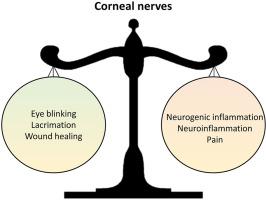Progress in Retinal and Eye Research ( IF 17.8 ) Pub Date : 2021-06-07 , DOI: 10.1016/j.preteyeres.2021.100974 Romina Mayra Lasagni Vitar 1 , Paolo Rama 1 , Giulio Ferrari 1

|
Corneal nerves are instrumental to maintain cornea integrity through regulation of key physiological functions such as tear secretion, blink reflex, and neuropeptide turnover. Corneal nerve injury/stimulation can follow many insults including mechanical/chemical trauma, infections and surgeries. Nerve disruption initiates a process named neurogenic inflammation which leads to edema, pain, and recruitment and activation of leukocytes. Interestingly, leukocyte influx in the cornea can further damage nerves by releasing inflammatory mediators-including neuropeptides. The clinical outcome of neuroinflammation can be beneficial or detrimental to corneal integrity. On one side, it ensures prompt wound healing and prevents infections. On the other, prolonged and/or deranged neuroinflammation can permanently disrupt corneal integrity and impair vision.
The cornea is an ideal site to study peripheral neuroinflammation and neurogenic inflammation since it receives the highest density of sensory nerves of the entire body.
We will review the corneal nerve anatomy and neurochemistry, discuss the beneficial and detrimental effects of neurogenic inflammation in corneal wound healing, inflammatory processes, and pain. We will also examine the emerging remote impact of corneal nerve disruption on the trigeminal ganglion and the brain, highlighting the key role of neuropeptide Substance P. Finally, we will discuss the clinical relevance of such neuroinflammatory network in the context of severe and highly prevalent ocular diseases, including potential treatments.
中文翻译:

神经和神经肽在角膜疾病中的双重作用
角膜神经通过调节泪液分泌、眨眼反射和神经肽更新等关键生理功能有助于维持角膜完整性。角膜神经损伤/刺激可能伴随着许多损伤,包括机械/化学损伤、感染和手术。神经中断会引发一个称为神经源性炎症的过程,该过程会导致水肿、疼痛以及白细胞的募集和激活。有趣的是,角膜中的白细胞流入可以通过释放包括神经肽在内的炎症介质进一步损害神经。神经炎症的临床结果可能对角膜完整性有益或有害。一方面,它确保伤口迅速愈合并防止感染。另一方面,长期和/或紊乱的神经炎症会永久性地破坏角膜完整性并损害视力。
角膜是研究外周神经炎症和神经源性炎症的理想场所,因为它接受了全身感觉神经的最高密度。
我们将回顾角膜神经解剖学和神经化学,讨论神经源性炎症对角膜伤口愈合、炎症过程和疼痛的有益和有害影响。我们还将研究角膜神经中断对三叉神经节和大脑的新兴远程影响,强调神经肽 P 物质的关键作用。最后,我们将讨论这种神经炎症网络在严重和高度普遍的眼部背景下的临床相关性疾病,包括潜在的治疗方法。


























 京公网安备 11010802027423号
京公网安备 11010802027423号